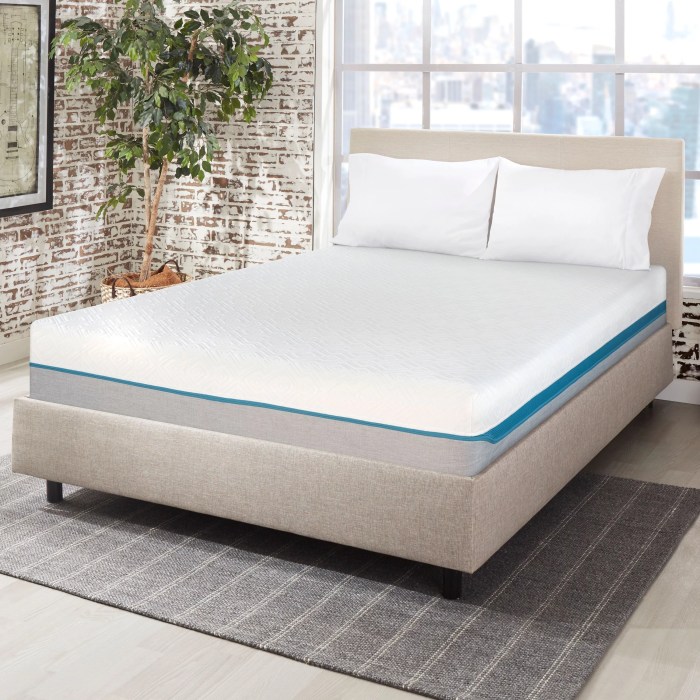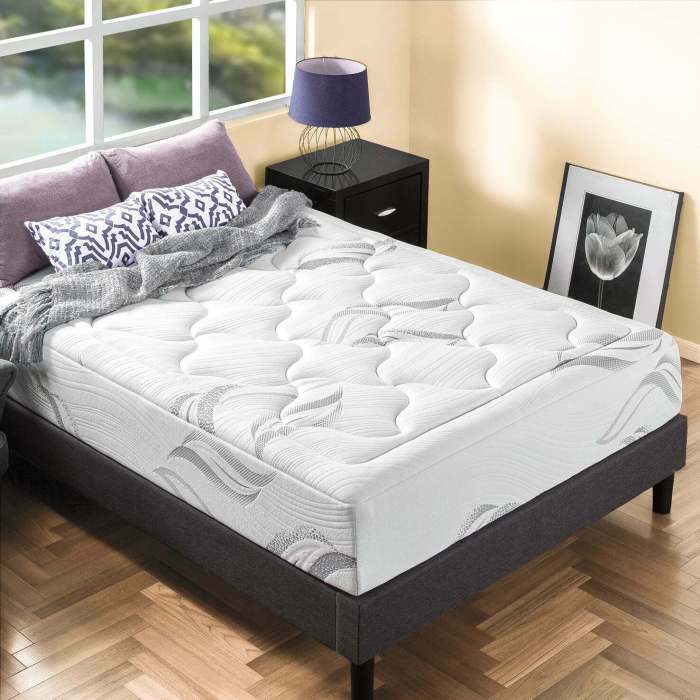In the realm of sleep, foam mattresses reign supreme, offering a symphony of comfort, support, and durability. Dive into this comprehensive guide to discover the intricacies of foam mattresses, from their construction to their innovative features.
Foam mattresses have revolutionized the sleep industry, providing sleepers with a personalized experience that caters to their unique needs and preferences. Explore the different types of foam, their construction, and the remarkable properties that set them apart.
Foam Mattress Construction and Materials

Foam mattresses have revolutionized the sleep industry, providing unparalleled comfort and support. They are constructed using various types of foam, each offering unique properties and benefits. Understanding the construction and materials used in foam mattresses is crucial for making an informed decision when choosing one.
Foam mattresses typically consist of multiple layers of foam, each serving a specific purpose. The top layer, often referred to as the comfort layer, is responsible for providing plushness and conforming to the sleeper’s body. The middle layer, known as the transition layer, provides support and helps distribute weight evenly.
The bottom layer, the support layer, forms the foundation of the mattress and ensures durability.
Types of Foam Used in Mattresses, Foam mattress
- Memory Foam:Memory foam is renowned for its ability to mold to the body’s contours, providing exceptional pressure relief and support. It is temperature-sensitive, softening in response to body heat, which allows it to conform closely to the sleeper’s shape.
- Latex Foam:Latex foam is derived from the sap of rubber trees and is known for its durability, breathability, and resilience. It offers excellent support and pressure relief, making it a popular choice for individuals with back pain or other orthopedic issues.
- Polyfoam:Polyfoam, also known as polyurethane foam, is a versatile and affordable foam type. It is lightweight and provides good support, making it a suitable option for budget-conscious shoppers or those who prefer a firmer sleeping surface.
Comfort and Support Features

Foam mattresses offer exceptional comfort and support due to their unique construction and materials. The conforming nature of foam allows it to cradle the body, providing pressure relief and reducing tossing and turning throughout the night. This is particularly beneficial for individuals with back pain, joint pain, or other pressure-related discomfort.
Pressure Relief
Foam mattresses excel at pressure relief by distributing body weight evenly across the surface. This prevents the formation of pressure points, which can cause discomfort and disrupt sleep. The soft and yielding nature of foam allows it to conform to the contours of the body, providing support without creating uncomfortable pressure.
Motion Isolation
Another significant advantage of foam mattresses is their excellent motion isolation capabilities. Unlike traditional spring mattresses, which can transfer motion across the entire surface, foam mattresses absorb and dissipate movement. This means that partners can sleep soundly without being disturbed by each other’s movements.
This is especially important for couples with different sleep patterns or those who tend to toss and turn frequently.
Comparison with Other Mattress Types
Compared to other mattress types, foam mattresses offer unique advantages in terms of comfort and support. Innerspring mattresses, while providing good support, may lack the same level of pressure relief and motion isolation. Hybrid mattresses, which combine foam and springs, offer a compromise between comfort and support.
However, foam mattresses often provide a more conforming and supportive surface for those seeking maximum comfort and pressure relief.
Health and Hygiene Aspects
Foam mattresses offer several health and hygiene benefits, contributing to a healthier sleep environment.
Hypoallergenic and Antimicrobial Properties
Foam is inherently hypoallergenic, making it a suitable choice for individuals with allergies or sensitivities. The absence of dust mites and other allergens in foam helps reduce allergic reactions and promotes a more comfortable sleep. Additionally, some foam mattresses are treated with antimicrobial agents to inhibit the growth of bacteria and mold, ensuring a cleaner and more hygienic sleep surface.
Breathability and Temperature Regulation
Foam mattresses are designed to be breathable, allowing air to circulate freely and prevent heat buildup. This breathability helps regulate body temperature, keeping sleepers cool and comfortable throughout the night. Open-cell foam structures further enhance breathability, providing superior air circulation and moisture wicking properties.
Maintaining Hygiene and Longevity
To maintain the hygiene and longevity of foam mattresses, regular cleaning and maintenance are essential. Vacuuming the mattress regularly helps remove dust and debris. For deeper cleaning, use a mild soap solution and a damp cloth to wipe down the surface.
Avoid using harsh chemicals or abrasive cleaners, as these can damage the foam. Additionally, rotate the mattress every few months to evenly distribute wear and tear and prolong its lifespan.
Durability and Maintenance
Foam mattresses generally have a lifespan of 7 to 10 years, depending on the quality of the materials used and the care given. With proper maintenance, you can extend the lifespan of your foam mattress and enjoy a comfortable sleep for many years to come.
Proper Care and Maintenance
To ensure the longevity of your foam mattress, follow these care tips:
-
-*Rotate your mattress regularly
Rotate your mattress head-to-toe and top-to-bottom every 3 to 6 months to distribute wear evenly and prevent sagging.
-*Use a mattress protector
A mattress protector can protect your mattress from spills, stains, and dust mites, which can shorten its lifespan.
-*Clean your mattress regularly
Vacuum your mattress every few months to remove dust and allergens. You can also spot-clean any stains with a mild detergent and water.
-*Avoid jumping or standing on your mattress
These activities can damage the foam and cause premature wear.
-*Keep your mattress in a dry environment
Moisture can damage the foam, so keep your mattress in a well-ventilated area and avoid placing it in a damp or humid environment.
Signs of Wear and Tear
Over time, even with proper care, your foam mattress may show signs of wear and tear. Here are some common signs to look out for:
-
-*Sagging
If your mattress has developed a noticeable dip or sag, it may be time to replace it.
-*Lumps or bumps
Lumps or bumps in your mattress can be caused by uneven wear or damage to the foam.
-*Loss of support
If your mattress no longer provides adequate support, you may wake up with aches and pains.
For those seeking an unparalleled sleeping experience, consider investing in a ripple mattress . Its innovative design conforms to your body, providing optimal support and pressure relief. With its unique wave-like surface, you’ll drift into a deep and restful slumber.
-*Cracks or tears
Cracks or tears in the foam can allow moisture and dust mites to enter, which can shorten the lifespan of your mattress.
Market Trends and Innovations
The foam mattress industry is constantly evolving, driven by technological advancements, changing consumer preferences, and a focus on sustainability.
Step into the future of footwear with the yeezy foam runner . These avant-garde sneakers combine style and comfort with their futuristic design and ultra-lightweight construction. Whether you’re hitting the streets or just kicking back, these shoes will elevate your look to new heights.
One of the key trends is the use of advanced materials, such as memory foam, latex, and gel-infused foams. These materials offer enhanced comfort, support, and durability, meeting the diverse needs of consumers.
Sustainable Practices
Sustainability is becoming increasingly important in the mattress industry. Manufacturers are adopting eco-friendly practices, such as using recycled materials, reducing waste, and implementing energy-efficient production processes.
Future Innovations
Looking ahead, we can expect continued innovation in foam mattress design and technology. Advanced sleep-tracking technologies, personalized comfort systems, and smart mattresses that adjust to individual sleep patterns are among the potential future developments.
Epilogue

As the future of sleep unfolds, foam mattresses continue to evolve, embracing advanced materials and sustainable practices. With their exceptional comfort, support, and durability, foam mattresses are poised to remain the cornerstone of restful nights for years to come.
Essential FAQs: Foam Mattress
What are the different types of foam used in mattresses?
Foam mattresses utilize various types of foam, including memory foam, latex foam, and polyfoam, each offering unique properties and benefits.
How do foam mattresses provide comfort and support?
Foam mattresses conform to the body’s contours, providing pressure relief and minimizing motion transfer, ensuring undisturbed sleep.
Are foam mattresses hypoallergenic and antimicrobial?
Yes, many foam mattresses are hypoallergenic and antimicrobial, creating a cleaner and healthier sleep environment.